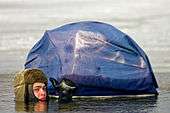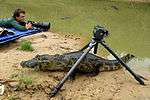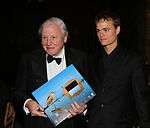Bence Máté
| Bence Máté | |
|---|---|
 | |
| Born |
February 26, 1985 Szeged |
| Nationality | Hungarian |
| Education |
Pusztaszer Elementary School Kiss Ferenc Forestry Vocational School |
| Occupation | Photographer |
| Years active | 1999-today |
| Title | Nature photographer |
| Awards |
BBC Wildlife Photographer Of The Year 2010, BBC Young Wildlife Photographer Of The Year 2002, Young Wildlife Photographer Of The Year Hungary 2000, 2001, 2002, 2003, 2004, Wildlife Photographer Of The Year Hungary 2006, 2008, 2010, 2013, 2015 |
| Website | www.matebence.hu |
Bence Máté is a Hungarian wildlife photographer. He pioneered the one-way glass photography technique[1] now popular among hide-based nature photographers around the world. In 2010, his image 'Marvel of Ants' won the prestigious Wildlife Photographer of the Year grand title, making him the only contestant to date to win the grand title prizes in both the young and adult categories of the competition.
According to the non-profit Bridge Budapest[2] association, Bence is the ninth most well-known Hungarian (living in Hungary), in the world.
Early years
Bence Máté was born in Szeged on 26 February 1985. His father, Gábor Máté is a maths and technology teacher; his mother, Ildikó Máté is a schoolteacher. He has a younger brother, Soma Máté. When Bence was two, the family moved to the edge of the village of Pusztaszer, and built a house by the wetlands. Bence’s bedroom window looked out onto reedbeds; it was here that he took his first bird photos.
Education

Bence Máté went to the primary school in Pusztaszer, where both his parents were teachers, but never felt as though he belonged in the classroom. Later, at the Kiss Ferenc Forestry High School in 1999, Bence felt increasingly constrained by the formal educational system. By the age of 13, he was spending most of his free time taking wildlife photos. His teachers noticed and supported this passion. Bence won third and second prizes for lectures he delivered, illustrated with his own images, in the Kitaibel Pál national conservation competition in 2000 and 2001 respectively. In 2001, Bence attended his first BBC Wildlife Photographer of the Year Award ceremony; his air fare was paid for by school staff. In 2003, he took six months off school to study English in London, where he made a living through temporary work such as gardening and working in the Ealing Broadway Burger King. When Bence went back to Hungary, he returned to his high school to begin his final year. But he missed too many classes, and from October 2003 was home-schooled. This allowed him to spend much more time on wildlife photography. In 2004, Bence was offered a place at the University of West Hungary. He never took up the offer, however; he was too busy taking photographs.
Early interests and career

In primary school, Bence joined the children's bird club and began to discover the natural riches around his village. His interest in nature increased as a result of the conservation and artisan nomadic camps he attended between 1993 and 1996, led by his Biology teacher, Zsolt Mészáros. Bence made money from rabbit farming and handicrafts and saved up to buy a Zenit 4.5/300 photo sniper, which he painted in camouflage colours so that he could get closer to birds. In November 1998, he built his first hide (out of reeds).
In 2000, Bence was named Hungary's 'Young Wildlife Photographer of The Year'. He won that title a total of five times between 2000 and 2004.
In 2002, at the age of 17, he became the youngest member of naturArt, the association of Hungarian Wildlife Photographers. He continued to build hides, including underground hides, and experimenting with his shots.
In 2001, the image 'Susliks' was highly commended in the BBC Young Wildlife Photographer of the Year competition and, the following year, in 2002, his image 'Recycling' won him the title of the BBC Young Wildlife Photographer of the Year.
Most famous pictures
.
Professional career


On 1 October 2003, at the age of 18, Bence founded a company and began to make a living from photo competitions, lectures, writing articles, building exhibitions and selling images, while continuing to spend thousands of hours in his hides. In November 2004, he switched from analogue to digital technology. In spring 2005, he experimented with a one-way glass photo technique, which allows him to photograph shy animals more closely without disturbing them. This technique soon became widespread among photographers shooting from hides.
Bence drew the attention of international profession when he won The BBC Wildlife Photographer of the Year’s Eric Hosking Award (for photographers aged 18–26) in 2005. He was invited to photograph wildlife of Pripyat National Park in Belarus as part of the National Geographic's Wild Wonders of Europe, one of the most significant photography-based conservation books, which featured 69 of the most talented and dedicated European wildlife photographers photographing the rich and varied natural heritage of 48 European countries.
In 2006, Bence launched an enterprise based on wildlife photography tourism. He renovated a farm and turned it into one of the most popular photographic venues for hide-based photography in Europe, thanks largely to his innovative one-way glass hides, which have transformed the practice of hide photography. In the same year, he was named Hungary's 'Wildlife Photographer of the Year' for the first time. He won this title in 2006, 2008, 2010, 2013, 2015, more times than any other person in the history of the competition.
His innovative vision, ideas, and astonishing technical solutions have reformed the practice of bird photography completely, and his achievements have proven that animals are worth photographed in action and showing their characteristic behaviour. From ethological point of view, interesting and rare moments typical to him are presented in special lighting, from extreme perspective. He is an ever renewing, style-making photographer.
Dr Zsolt Kalotás, founding president of the Society of Hungarian Nature Photographers
BBC Wildlife Photographer of the Year, Costa Rica, Brasil, South Africa

Between November 2008 and April 2009, Bence worked in Costa Rica, building hides for wildlife photography purposes, going on to do similar work in Brazil from September 2009 until March 2010, developing his skills in planning, designing hides and experimenting with different materials and construction techniques.
In 2010, his image of leaf-cutter ants, entitled 'Marvel of Ants', won him the Wildlife Photographer of the Year, and Bence became the only photographer in the history of the competition to win the Grand Prize in both the young and adult category In 2010, Bence was named Honorary Citizen by the village of Pusztaszer in recognition of his contribution to the local community.
In 2012 he built his underwater metal hide known as the 'Theatre'. He designed exclusive bird and big game hides for Zimanga Private Game Reserve in South Africa, which started a business based on the most extraordinary African photo hides as an alternative to classical safaris.
His credo about wildlife photography
A great wildlife photo is technically perfect, innovative, and unrepeatable. It is a genuine reflection of what took place, and the subjects must be able to move around as they wish. Whilst Photoshop can be used to enhance an image, the sole goal of post-production should be to reflect reality in the most accurate way possible.
Equipment
| Year | Camera body | Lens |
|---|---|---|
| 1998 | Zenit ES | Zenit 2,8/50, 4,5/300mm |
| 2000 | Chinon CG5 | Pentacon 2,8/135, 5,6/500mm |
| 2001 | Nikon 8008s | Nikon MF2,8/300mm |
| 2002 | Nikon 8008s | Nikon 2,8/20, 2,8/105 Macro, MF2,8/300mm |
| 2003 | Canon EOS-1N RS | Nikon 2,8/20, 2,8/105 Macro, MF 2,8/300mm, Canon MF 5,6/800mm |
| 2004 | Canon 300D, EOS-1N RS | Nikon 2,8/20, 2,8/105 Macro, MF 2,8/300mm, Canon MF 5,6/800mm |
| 2006 | Nikon D200, Panasonic FZ30, FZ50 | Nikon 2,8/20, 2,8/105 Macro, MF 2,8/300mm |
| 2008 | Nikon D300, Panasonic GH1 | Nikon 2,8/20, 2,8/105 Macro, 2,8/300mm, Sigma 5,6/300-800mm |
| 2009 | Nikon D300, D700, Panasonic GH2 | Nikon 2,8/20, 2,8/105 Macro, 2,8/70-200, 2,8/300mm, Sigma 5,6/300-800mm Tokina 10-17mm fisheye |
| 2010 | Nikon D300, D700, Panasonic FZ100 | Nikon 2,8/20, 2,8/105 Macro, 2,8/70-200, 2,8/300mm, Sigma 5,6/300-800mm, Tokina 10-17mm fisheye |
| 2012 | Nikon D700, D800, Panasonic FZ150, FZ200 | Nikon 2,8/20, 2,8/105 Macro, 2,8/70-200, 2,8/300, 4/200-400mm, Sigma 5,6/300-800mm, |
| 2013 | Nikon D700, D800, D3S | Nikon 2,8/20, 2,8/105 Macro, 2,8/70-200, 2/200, 2,8/300, 4/200-400mm, Sigma 2,8/15 fisheye, 5,6/300-800mm, Tamron 2,8/14-28 |
| 2014 | Canon 1DX, Nikon D800, D3S, Panasonic GH4 | Canon 70-200, 200-400mm, Nikon 2,8/20, 2,8/105 Macro, 2,8/70-200, 2/200, 2,8/300, 4/200-400mm, Sigma 2,8/15 fisheye, 5,6/300-800mm, Tamron 2,8/14-28 |
| 2015 | Canon 1DX, Nikon D800, D3S, Panasonic GH4, FZ300 | Canon 2,8/15 Fisheye, 2,8/16-36, 2,8/70-200, 1,2/85, 2,8/100 Macro, 2/200, 2,8/400, 4/200-400mm, Sigma 2,8/15mm fisheye, Tamron 2,8/14-28mm |
Since 2006 Bence has been one of the 'faces' of Panasonic,[3] thanks largely to the fact that his photography demonstrates what can be achieved with starter level equipment. He tests the latest Panasonic cameras in extreme situations in countries such as Costa Rica, Brazil, Norway, Hungary, Sri Lanka and Africa.
Significant awards
- Young Wildlife Photographer of the Year (international), 2002
- Wildlife Photographer of the Year (international), 2010
- Young Wildlife Photographer of the Year (Hungary), 2000, 2001, 2002, 2003, 2004
- Wildlife Photographer of the Year (Hungary), 2006, 2008, 2010, 2013, 2015
- Wildlife Photographer of the Year: Eric Hosking Award for the best portfolio, 2005, 2007, 2010, 2011
- Wildlife Photographer of the Year (international): Birds category, Winner, 2014
- Bird Photographer of the Year (England), 2005
- GDT – European Wildlife Photographer of the Year (Germany), 2015, Mammals category, Winner
- Nature’s Best Photography competition (USA), 2010, 2012, 2014, Category 1st prize
- Environmental Photographer of the Year (England), 2010, Category 1st prize
- Memorial Maria Luisa Photo Contest (Spain), 2010, Overall winner
- MontPhoto International photography contest (Spain), 2014, 2015, Overall winner
- Aves International Photo Contest (Belgium), 2014, Overall winner
- Transnatura International Nature Photo Competition (Romania), 2015, Overall winner
- National Wildlife international wildlife photography competition (USA), 2014, Overall winner
- EuroNatur International Photography Competition (Germany), 2014, Overall winner
Wildlife Photographer of the Year ranking
|
|
Other awards and recognition
- Pro Natura award, 2016[4]
- Junior Prima award, 2014[5]
- Blikk – Man of the Year, press category, 2013[6]
- One of the 30 successful young Hungarians under 30, 2014 (Forbes magazine)[7]
- The 9th best known contemporary Hungarian, 2014 (Bridge Budapest)[8]
- Top 10 – leading Hungarians in the world, 2015 (Culture category)[9]
Charitable activity

Bence's role model is Csaba Böjte, a monk of the Franciscan Catholic order, who founded St Francis Foundation for orphans and children in need. So far, the foundation has helped 5,000 children. Bence has been cooperating with Brother Csaba, building hides for the foundation. Since 2013 he has been taking part in the Honorary Godparent programme, which offers an opportunity to contribute to a child's care.
The popularity of the television series 'The Invisible Bird Photographer' among children inspired Bence to design wildlife photography playgrounds, introducing children to wildlife photography. The hides are equipped with one-way glass, electric heating and nextboxes as well as monkey bars and slides in order to encourage children take part in outdoor activities.
Bence offers his images free of charge to Hungarian national parks to use for conservation purposes. Since 2013, he has been nominated Ambassador of National Parks.
Books

- The Invisible Wildlife Photographer – ISBN 978-963-06-9845-0. English and Hungarian. Five hundred copies of the first signed, hand-bound limited edition were published with a cover that included a piece of glass similar to the one used by the photographer. The book is no longer available; the collectors' price is around €150. The second edition is a simplified, smaller album. The photos, text and publishing rights belong to the author (www.matebence.hu).
- The Handbook of Bird Photography – ISBN 978-1-937538-10-1. A practical handbook of bird photography with lots of useful advice, from hide building and flash techniques to participation in competitions. Co-authors: Markus Varesvuo and Jari Peltomäki; publisher: Rocky Nook. English, German, French and Finnish.
Films
'The Invisible Bird Photographer'. The természetfilm.hu scientific film workshop, owned by Chello Media, was commissioned by Spektrum Television to shoot a 3 x 26-minute series, which was a huge success. The slow motion camera shots were prepared by Bence. Director: Attila Molnár; cinematographer: Zsolt Marcell Tóth, Bence Máté; narrator: Péter Rudolf.
Part 1: The miracle water
Part 2: The three tenants
Part 3: Fish dinner
References
- ↑ "Speaking birds language - National Geographic Russia". hidephotography.com. Retrieved 2016-04-28.
- ↑ http://bridgebudapest.org
- ↑ "GH4 SPECIAL GALLERY - Panasonic". www.panasonic.com. Retrieved 2016-04-29.
- ↑ https://www.facebook.com/BenceMatesPhotography/photos/a.169029539790432.46034.168855733141146/1338028726223835/?type=3&theater
- ↑ http://primissima.hu/junior-prima-eddigi-dijazottak/
- ↑ http://blog.volgyiattila.hu/2012/01/31/mate-bence-lett-az-ev-remenysege/
- ↑ http://www.szeretlekmagyarorszag.hu/forbes-30-sikeres-magyar-fiatal-30-alatt/
- ↑ http://www.bumm.sk/archivum/2014/10/04/100072_ime-a-tiz-legsikeresebb-vilaghirnevnek-orvendo-magyar
- ↑ http://welovebudapest.com/elmeny.kultura/kiadvanyba.gyujtottek.napjaink.magyar.sikereit